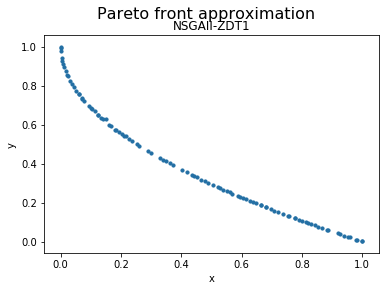NSGA-II¶
Example¶
[1]:
from jmetal.algorithm.multiobjective.nsgaii import NSGAII
from jmetal.operator.crossover import SBXCrossover
from jmetal.operator.mutation import PolynomialMutation
from jmetal.problem import ZDT1
from jmetal.util.termination_criterion import StoppingByEvaluations
problem = ZDT1()
max_evaluations = 25000
algorithm = NSGAII(
problem=problem,
population_size=100,
offspring_population_size=100,
mutation=PolynomialMutation(probability=1.0 / problem.number_of_variables, distribution_index=20),
crossover=SBXCrossover(probability=1.0, distribution_index=20),
termination_criterion=StoppingByEvaluations(max=max_evaluations)
)
algorithm.run()
solutions = algorithm.get_result()
We can now visualize the Pareto front approximation:
[3]:
from jmetal.lab.visualization.plotting import Plot
from jmetal.util.solution import get_non_dominated_solutions
front = get_non_dominated_solutions(solutions)
plot_front = Plot(plot_title='Pareto front approximation', axis_labels=['x', 'y'])
plot_front.plot(front, label='NSGAII-ZDT1')

API¶
- class jmetal.algorithm.multiobjective.nsgaii.NSGAII(problem: ~jmetal.core.problem.Problem, population_size: int, offspring_population_size: int, mutation: ~jmetal.core.operator.Mutation, crossover: ~jmetal.core.operator.Crossover, selection: ~jmetal.core.operator.Selection = <jmetal.operator.selection.BinaryTournamentSelection object>, termination_criterion: ~jmetal.util.termination_criterion.TerminationCriterion = <jmetal.util.termination_criterion.StoppingByEvaluations object>, population_generator: ~typing.Generator = <jmetal.util.generator.RandomGenerator object>, population_evaluator: ~jmetal.util.evaluator.Evaluator = <jmetal.util.evaluator.SequentialEvaluator object>, dominance_comparator: ~jmetal.util.comparator.Comparator = <jmetal.util.comparator.DominanceComparator object>)[source]¶
Bases:
GeneticAlgorithm[S,R]- replacement(population: List[S], offspring_population: List[S]) List[List[S]][source]¶
This method joins the current and offspring populations to produce the population of the next generation by applying the ranking and crowding distance selection.
- Parameters:
population – Parent population.
offspring_population – Offspring population.
- Returns:
New population after ranking and crowding distance selection is applied.
